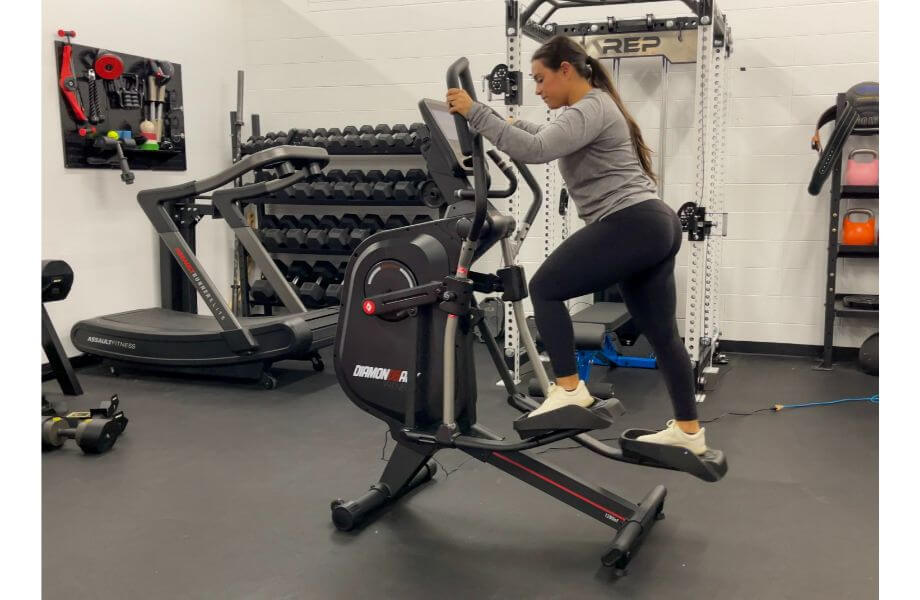We test and review fitness products based on an independent, multi-point methodology. If you use our links to purchase something, we may earn a commission. Read our disclosures.
At some point during your fitness journey, you’ve likely used an elliptical machine. Most gyms have them, and even if you prefer doing treadmill workouts as your main form of cardio, there will be times when the treadmill isn’t available. A 2011 Gait Posture1 study found that “Elliptical training demonstrated greater quadriceps activity and greater quadriceps/hamstrings coactivation than all other conditions.”
As great as the elliptical can be, some folks may experience knee pain from elliptical training, typically due to poor posture, not keeping your heels on the pedals, previous ligament or knee injuries, or overuse. Although I can’t guarantee injury prevention, I can give you expert tips to protect your knees based on my 10 years of experience as a fitness enthusiast and certified personal trainer.
RELATED: Best Ellipticals For Home
I’ll begin with how an elliptical machine works before going through the common causes of knee pain from elliptical training. Next, I’ll share five tips to protect your knees on the elliptical. To finish, I have a warm-up for an elliptical workout and some knee-friendly alternatives should this machine continue to cause you knee pain.
Without further ado, let’s get started!
How Does An Elliptical Work?
An elliptical—also referred to as a cross-trainer—works by first stepping onto the pedals. Then, you hold the handlebars and set your program or intensity on the console. Once ready, you move forward (or backward) using both your arms and legs. The elliptical combines three different motions—walking, stair climbing, and running—and is one of the most popular cardio machines because it’s less weight-bearing than other forms of cardio.
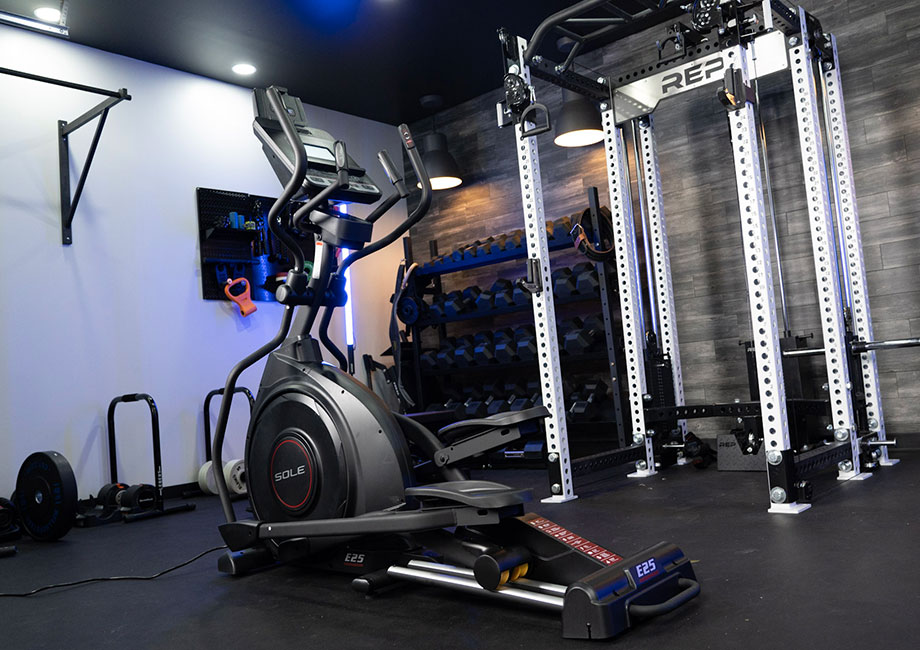
Common Causes of Knee Pain From Elliptical Training
So, what are the common causes of knee pain from elliptical training? Although many people find the elliptical more joint-friendly than other pieces of cardio equipment, here are four reasons why it may cause knee pain:
1. Not Maintaining An Upright Posture
Your whole body should be upright when you use the elliptical. Some people tend to lean forward with their upper body, which can cause pressure on both your knees and lower back. If you’re new to elliptical exercise, remind yourself to reset your posture until it becomes second nature. Your knees will thank me for it later!
2. Using the Elliptical For Too Long
Overuse injuries are a real thing, especially for beginners to cardiovascular exercise. I get it—you’ve set a fitness goal (for example, weight loss) and want to achieve it as quickly as possible. You’ll spend as much time as you can on the elliptical, but using it for too long can lead to joint pain. Stop when you’re feeling tired, and take rest days. It’s a marathon, not a sprint.
RELATED: Beginner Elliptical Workouts
3. Not Keeping Your Heels on the Pedals
When you use an elliptical trainer, your heels should stay flat against the pedals. Time and time again, I’ve seen gym-goers shift their body weight to their toes. When this occurs, you’ll use your quadriceps more than you need to, causing unnecessary strain on your knee joints. From experience, this can be a sign that you’ve been on the exercise machine for too long.
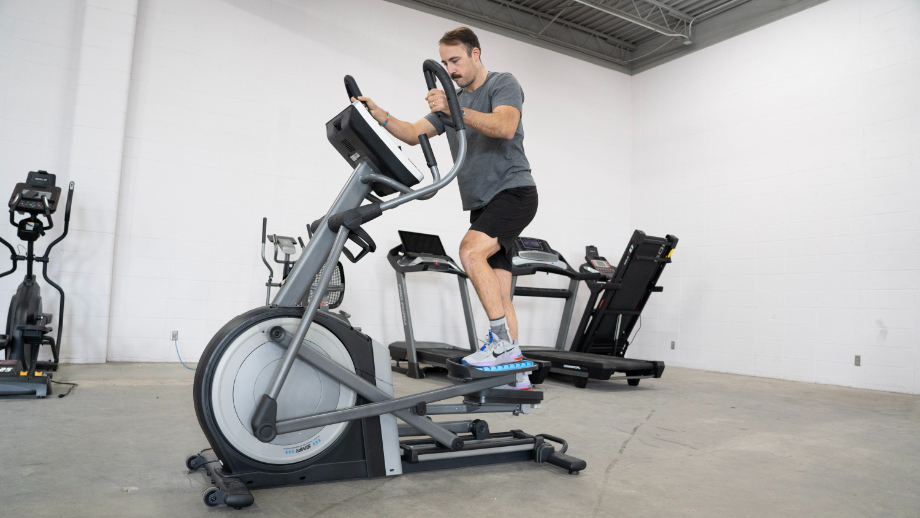
4. Previous Knee Injury or Osteoarthritis
This goes without saying. If you’ve had a knee injury in the past or have osteoarthritis, the elliptical may cause knee pain. You may need to see a physical therapist before continuing because the last thing that you want to do is make things worse. Yes, the elliptical is a low-impact exercise, but this doesn’t always hold for those with previous knee injuries.
How To Protect Your Knees on the Elliptical
Short answer: you’ll want to keep your knees in line with your toes, warm up and cool down properly, strengthen your leg muscles, wear the correct shoes, and use the right stride length. I’ll elaborate:
1. Keep Your Knees in Line With Your Toes
When you do back squats or deadlifts, you keep your knees in line with your toes to prevent knee pain. The same principle applies during elliptical training. If your toes point slightly outward when you step onto the elliptical (as mine do!), you’ll need to make an effort to push your knees out, too, which may feel strange at first but becomes second nature over time.
2. Warm Up and Cool Down Properly
I’ve provided you with a warm-up for your next elliptical workout below. You can use mine or create your own, but either way, it’s important to warm up and cool down before and after a cardio workout session. Warming up raises your heart rate, increases blood flow throughout your body, and improves flexibility. Cooling down reduces muscle stiffness and shortens recovery time. Both help to prevent knee pain or aggravation.
3. Strengthen Your Lower-Body Muscles
Your knee joint and kneecap (aka patella) are less likely to get injured if you strengthen the muscle groups in your lower body, including your quads, hamstrings, glutes, and calves. In particular, the thigh quadriceps muscle2 and hamstring muscle group3 are responsible for knee extension and knee flexion, respectively, so add some of the best leg exercises into your workout routine.
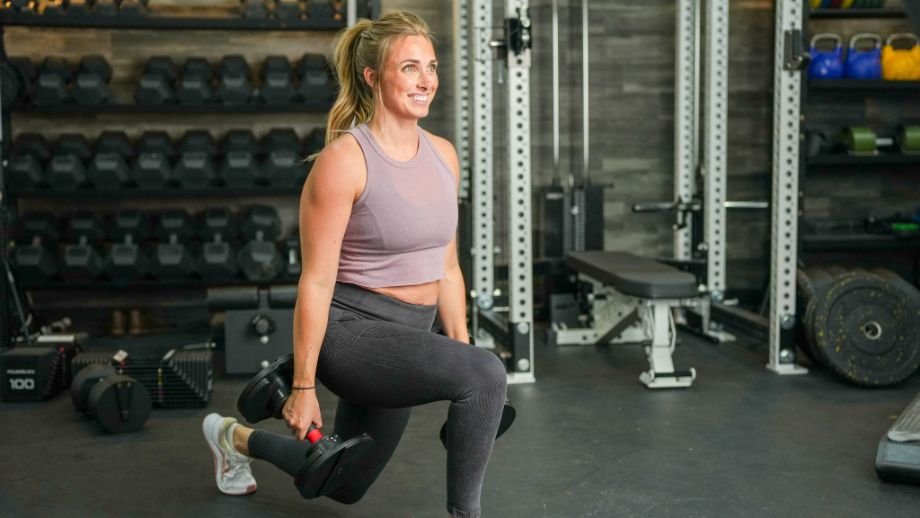
4. Wear the Correct Shoes
In our training shoes guide, our experts discuss what to look for in a good pair of running shoes. I appreciate that we’re not running in the traditional sense, but we’re still doing aerobic or cross-training exercises. Everyone is different, so what works for one person may not work for another. Still, it’s important to find a pair of shoes that are comfortable, flexible, cushioned, and offer traction.
RELATED: Best Cross-Training Shoes
5. Use the Right Stride Length
Not every elliptical machine has an adjustable stride length, but if yours does, this could make a difference in protecting your knees. If you’re overextending or underextending, this won’t feel natural or comfortable and may strain your knees. If adjusting your stride length isn’t an option, avoid setting the resistance or incline at excessively high levels.
How To Warm Up For an Elliptical Workout
Before doing an elliptical workout, you’ll want to warm up for muscle activation. Doing so increases blood flow around the body, improves flexibility, and prevents injury. As a certified personal trainer (CPT), here’s a warm-up for an elliptical workout that I would give to my clients:
- Light cardio exercise (5 minutes): If you happen to walk to the gym, feel free to skip this step. Otherwise, hop on a treadmill, rower, or stationary bike, set the resistance low, and start moving. This is especially important if you’ve been sitting for a long period or it’s cold outside and you need to warm up in more ways than one.
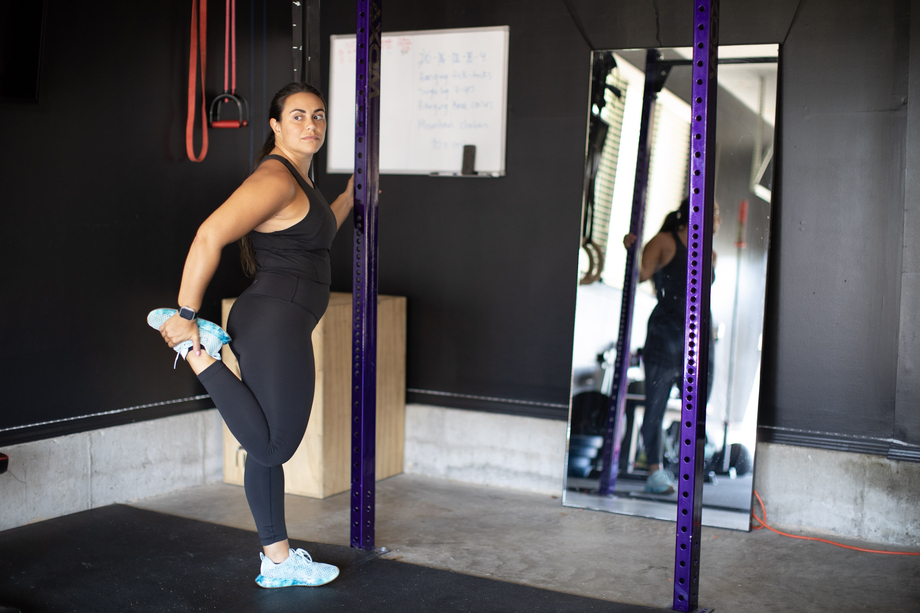
- Dynamic exercises (5 minutes): Examples of fantastic dynamic exercises include arm swings and circles, leg swings, lunges, jumping jacks, resistance band pull-aparts, and more (just check out our guide to the best warm-up exercises). Perform each exercise for 30 to 60 seconds before moving on to the next.
Once you’ve completed the above, you’re ready to get started with your elliptical workout.
RELATED: Elliptical Workouts For Runners
Knee-Friendly Elliptical Alternatives
Regardless of the changes you make to protect your knees, you might find that the elliptical continues to cause you knee pain. Worry not—here are a few elliptical alternatives that may help you reap the benefits of cardio without (hopefully!) experiencing unnecessary knee pain:
- Swimming or water aerobics
- Rowing machines (see Rowing Machine vs. Elliptical)
- Stationary or recumbent cycling
- Walking
- Yoga
- Pilates
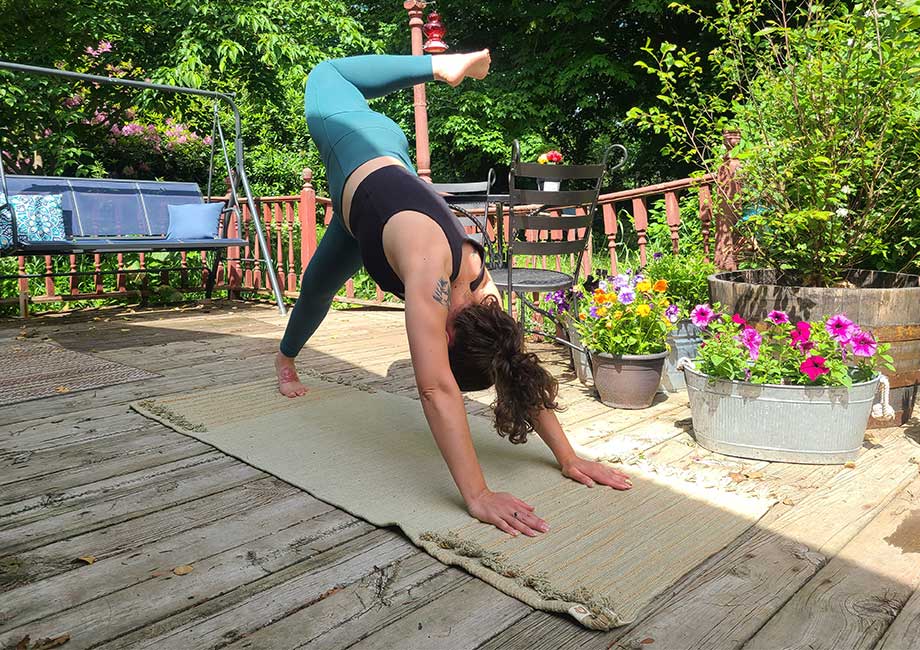
Everybody is different, so what works for you may not work for another. I’d recommend trying out a few different exercise routines before deciding the best option for you. For example, I enjoy swimming, walking my dog, or yoga when I need a solid, knee-friendly cardio session.
RELATED: Best Cardio For Bad Knees
Knee Pain From Elliptical: Final Thoughts
The elliptical trainer is known as a low-impact cardio exercise because it’s easier on your joints. However, some may still experience knee pain from elliptical training. This can be due to incorrect form (not maintaining an upright posture or not keeping your heels on the pedals), overuse, or previous knee injuries and osteoarthritis.
To prevent this, you’ll want to keep your knees in line with your toes, warm up and cool down properly, strengthen your leg muscles, wear the correct shoes, and use the right stride length. If this doesn’t make a difference, consider physical therapy. Alternatively, try knee-friendly elliptical alternatives such as swimming, cycling, yoga, walking, and more.
Knee Pain From Elliptical: FAQs
Can elliptical machines cause knee pain?
Yes, elliptical machines can cause knee pain due to incorrect form, overuse, previous knee injuries, or osteoarthritis. However, it’s worth noting that the elliptical trainer is one of the more joint-friendly pieces of cardio equipment, and any equipment in the gym or at home can cause knee pain.
There are several ways to protect your knees during elliptical workouts. You’ll want to warm up and cool down properly, keep your knees in line with your toes, strengthen your lower body muscles, wear the correct shoes, and use the right stride length. If this doesn’t work and you’re still experiencing knee pain from elliptical training, do an alternative cardiovascular exercise.
Which elliptical is best for bad knees?
For bad knees, I suggest that you choose an elliptical with cushioned foot pedals, an adjustable stride length, and a variety of incline settings. If possible, try different elliptical machines before you commit if you intend on buying one for your home gym.
You can also check our guide to the best commercial ellipticals, where our equipment experts have chosen the best elliptical for bad knees based on a custom list of in-depth questions and criteria.
What are the side effects of the elliptical machine?
Common side effects of the elliptical machine include muscle soreness (aka DOMS), lower back pain, shortness of breath, and knee pain. If you experience muscle soreness, reduce the time spent on the elliptical and warm up and cool down properly.
For those with lower back or knee pain from elliptical machines, you’ll want to keep your knees in line with your toes, build muscle in your legs and core, warm up and cool down properly, wear the correct shoes, and use the right stride length.
Shortness of breath is normal for those new to elliptical training, and should lessen once you’re more comfortable on the machine.
What gym machines should you avoid with bad knees?
Based on my 10 years of experience as a fitness enthusiast and certified personal trainer (CPT), the following machines may not be suitable for those with bad knees:
– Treadmill
– Leg extension
– Leg curl
– Leg press
– Hack squat
– StairMaster
– Smith machine (for lower-body exercises, such as squats or lunges)
You shouldn’t avoid all of the above; just be mindful. If the treadmill or StairMaster is causing you knee pain, switch to a stationary bike or elliptical. There are plenty of lower-body exercises that you can do with dumbbells, barbells, or your body weight, so there’s no reason to continue performing leg curls, leg extensions, or leg presses if they’re hurting your knees.
References
- Prosser LA, Stanley CJ, Norman TL, Park HS, Damiano DL. Comparison of elliptical training, stationary cycling, treadmill walking and overground walking. Electromyographic patterns. Gait Posture. 2011 Feb;33(2):244-50. doi: 10.1016/j.gaitpost.2010.11.013. Epub 2011 Jan 6. PMID: 21215636; PMCID: PMC3299003.
- Bordoni B, Varacallo M. Anatomy, Bony Pelvis and Lower Limb: Thigh Quadriceps Muscle. [Updated 2023 May 8]. In: StatPearls [Internet]. Treasure Island (FL): StatPearls Publishing; 2024 Jan-. Available from: https://www.ncbi.nlm.nih.gov/books/NBK513334/
- Rodgers CD, Raja A. Anatomy, Bony Pelvis and Lower Limb, Hamstring Muscle. [Updated 2023 Apr 1]. In: StatPearls [Internet]. Treasure Island (FL): StatPearls Publishing; 2024 Jan-. Available from: https://www.ncbi.nlm.nih.gov/books/NBK546688/
Further reading

In this article, we take a look at the tortuous, incredibly history of treadmills. Read more

Looking for a smartwatch that can track your important fitness milestones? This Withings ScanWatch review could help you decide if this is the watch you seek. Read more

These 100+ workouts add volume to your training, target increased muscle size and set you up for getting stronger. Read more

Using several metrics to assess safety for runners, here is our list for the 10 best cities for running. Read more

